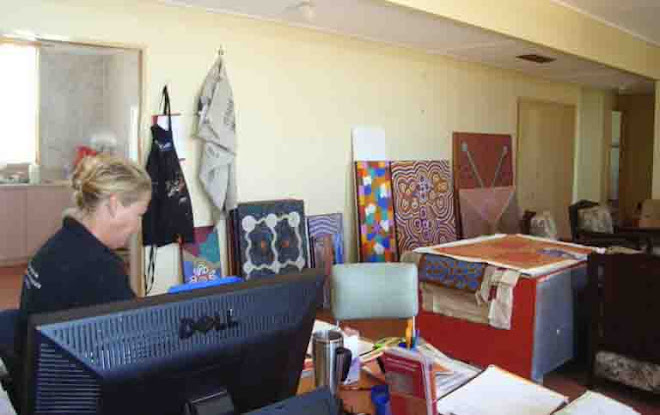It is frustrating when the white staff who live in remote communities bypass the art centre, and purchase direct from the artists thinking they are getting a ‘piece of Aboriginal artwork’ for a bargain. They are kidding themselves. The ‘so’ called bargain in most cases has been painted on a cheap Chinese-made canvas bought from a ‘Mad Harry’s’ outlet and executed with inferior acrylic paint. These cheap canvases and paint become brittle with age and within five years or so will begin to deteriorate if the canvas hasn’t already been punctured.
Purchasing from an art centre ensures you get quality - the linen (usually, Belgium) or 12-14oz cotton canvas has been properly stretched, prepared with two to three base coats, painted using premium acrylic paint and is accompanied by a certificate of provenance explaining the story and guaranteeing authorship. A painting executed by an artist living in their homeland or country has a magical, exquisite quality, articulating pleasure not pressure and when sold through the community art centre will always hold its value due to its unquestionable provenance.
If only the market would become less obsessed by ‘in vogue’ artists, their own personal status, and more interested in provenance and purchasing from ethical sources. The Indigenous Australian Art Commercial Code of Conduct if and when workably applied by the Labour Government will certainly be a catalyst for hope and change.
They are those who rebuke and condemn the ‘Aboriginal art centre’ model. It is not perfect, has its flaws and like any business or organisation its success is determined by the skills of the Manager/s. Given most art centres are located in remote areas and offer low salaries typical of the arts industry in Australia it is now wonder there is a shortage of suitable staff.
The Manager’s responsibilities/duties are wide-ranging, varying in skills. We are required to operate a small business – the art centre, which also doubles as an informal art school. You need to have an appreciation of arts practice; business management capabilities including sales and marketing, financial administration and efficient office procedure; interpersonal and cross-cultural communication skills; flexibility, ability to cope with more than one project at a time, expertise in planning and project management skills; leadership and mentoring skills; and finally the aptitude to work independently.
Our working environment is out-of-the ordinary, subject to cultural authority, and at times, very demanding. The nature of the job guarantees a great deal of your working knowledge will be gained by experience alone. You are expected to act ethically and appropriately, with the interests of the art centre foremost, at all times. Concisely, the job is bloody hard…wimps need not apply!
Back to our model…And yes, I agree every artist has the right to choose who they want to represent them, however Aboriginal artists lack the literacy and numeracy skills, let alone the ability to scrutinise a complex industry to make informed decisions. Add the pressure to paint for drinking/gambling money or a car placed on them by their families and you have a pathway to entrapment. Worldwide, Indigenous minority groups have always suffered at the hands of people who abuse their position and trust by taking advantage of these displaced people, fringe dwellers, existing outside our western society. I am not convinced that relationships between artists and many of the private dealers are equitable, nor adhering to principles of fair trade. Behind closed garage doors, there is a lack financial transparency, lack of ownership/control by the artists, a loss of cultural integrity, the artist's integrity is ignored and production (with the help of family and friends) becomes the driving force. Artists loose control of their lives, obligated to their families and the dealer’s demands.
If only people realised there wouldn’t be a need for authenticity certificates if all clients bought direct from art centres or ethical dealers/galleries who also purchased directly art centres!
Subscribe to:
Post Comments (Atom)


1 comment:
Hi Sarah,
Don't know if you are still keeping this blog but i found it via another website and I want to thank you for giving a viewpoint on an issue which is too complicated for anything but a complex response. Sold some (john coburn) art about 3 months ago for an unexpectedly good price- the first time I have ever sold art as opposed to buying it and have been on an amazing voyage ever since. You see, I made a deal with my husband that any proceeds could be spent on more art and I suddenly had quite alot to spend! What a shock to find that while busy with other aspects of life, a whole new style of aboriginal art had popped out of nowhere and it was spectactular! unfortunately, I have spent it all now and sold my royal doulton and old jewelry to buy more, but I keep coming back to tjungu palya and tjala and warakurna and I just can't stop looking. My poor husband calls it art porn and I have had to promise to buy no more for a year..
Have waded through the whole ebay temptation and lots of published information that alludes in a non-litigation inducing way to some of the barriers you face and I think I have the gist of it and it sounds really soul destroying.
Anyway, just wanted to say congratulations and well done. Your efforts have enabled the discovery and promotion of some wonderful artists...
Post a Comment